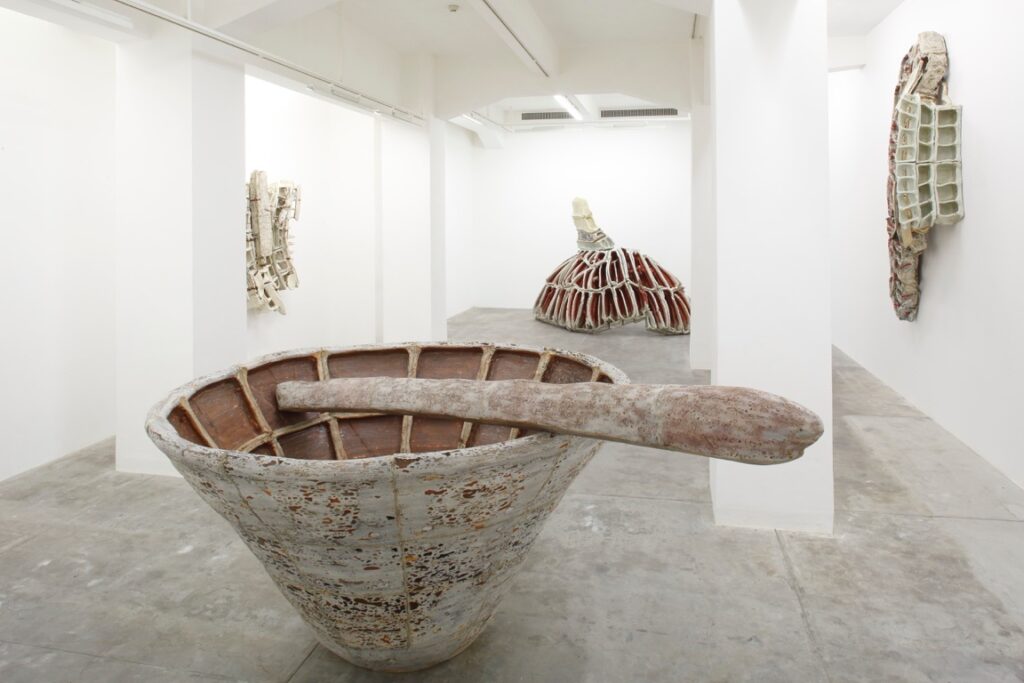To Shape Clay as a Painter Paints
I was looking at a landscape, or should I say, what ought to have been a landscape, in black and white, light seared by inextinguishable flames onto a sheet of photographic paper. A familiar scene of the streets of an older, downscale section of Kobe where I had been born and raised, but on January 17, 1995, it was transformed into a wasteland like those in photographs taken after World War II air raids. The scene before my eyes was something I had never witnessed or experienced before. At the same time I felt déjà vu, and shortly afterward it occurred to me to wonder how I could experience this when I had never actually seen such an extraordinary scene before with my own eyes, only in mental images. The more remorseless a reality is––the harder for the mind to accept––the more likely it is to be a genuine reality. I could not help but feel that at times like these, fighting back against reality by making works of art is a futile endeavor.
At the same time, it can be a way of transcending reality. It is not an act of falsification, but it is one of artifice, invention, fiction. Just as drawing is not merely copying the shapes of things but rather expressing one subjective view of them, sculptural art is not a means of depicting things just as they are, but rather a set of perspectives or interpretations of the world around us. Through the visual faculties, we can share and convey views of the shapes and structures of the visible world, in the same manner as a musical score or text. Sharing expression with one another in this way provides human beings with the spiritual strength to survive, and gives the sustenance we need to transcend the realities surrounding us.
When a manmade structure collapses, it is no longer a structure, and we call it rubble. The validity of sculptural art is similarly fragile, and is preserved by the delicate equilibrium of material (the natural) and the artist’s intent (the artificial). Over the past dozen or so years, I have been working with slabs of clay and assembling them into forms, exploring this equilibrium. I put together more than one hundred slabs at times, building squared-off tubular or box-like structures, each one configured differently. After they dry I dismantle them, fire the parts, and reassemble them into a single work. The process is one of continuous labor. I want the finished products to have the solidity and stern countenance of the structures of our forebears and of the animal kingdom, structures that bear the legacy of tireless toil of hands and bodies, of the farmer in pre-industrial times who stacked stones one by one into a wall to protect his field, or of the bees who single-mindedly work to build their hives and carry on their species.
However, continuous labor does not necessarily create art, it only leaves behind evidence of action. Other processes are required to create an interpretation the world around us, rather than simply a record or inscription. Above all, clay is malleable, and everyone knows what it feels like to mold it with the hands. Clay can be shaped no matter who works with it and what they do, but in most cases the result will only be a record of their actions. When the artist shapes clay, however, it is an act of bending the clay to one’s will, transforming it into the form one seeks. The crux of the matter is the artist’s sympathy with the form that has emerged. In other words, the process is one of verifying whether the form the artist sought to create and the one that has actually emerged are in accord with one another. Sculpting is a cycle repeated countless times, a back-and-forth between the material (the natural) and the artist’s intent (the artificial). The artist must ceaselessly verify whether what he or she has built is worthy of comparison to the impregnable structures built by bees. The hands shape clay, leaving traces that depict an image just as in the process of painting. I seek to make forms in the same way that painters paint images on canvas.
2014.07 “Palimsest - Overwritten Memories/Superimposed Memories vol.3 Masayuki INOUE” αM, Tokyo

